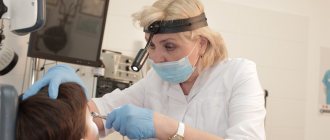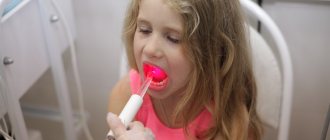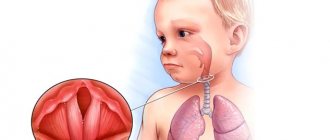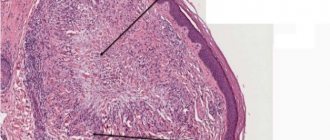Rhinitis, or, as it is more simply called, a runny nose, is an inflammation of the nasal mucosa, causing difficulty in breathing freely through the nose.
Author:
- Galkin Alexey Vladimirovich
ENT pathology expert
(Voted by: )
Rhinitis , or, as it is more simply called, a runny nose, is an inflammation of the nasal mucosa, which makes it difficult to breathe through the nose. The infectious process is characterized by copious mucous discharge from the nose, congestion, sneezing, a feeling of squeezing in the bridge of the nose, loss of smell, and headache. This is a common disease: it accounts for up to a third of all ENT diseases in childhood. Even a newborn can get rhinitis; the disease has no age restrictions.
With frequent episodes of recurrence of rhinitis, the child’s general, including psychological, health suffers, his performance at school decreases, and complications may arise (otitis media, sinusitis, bronchitis, etc.). It is important to prevent the disease from exacerbating and becoming chronic, so at the very beginning of the development of a runny nose, you should consult a pediatrician. There are several types of rhinitis. When making a diagnosis and prescribing treatment, one must proceed from the specifics of its course and the causes of its occurrence. Only a doctor can prescribe effective therapy that will quickly relieve the child of the disease, will not cause adverse reactions and will prevent frequent relapses.
Manifestations of acute rhinitis in newborns and infants
Acute rhinitis is especially unpleasant in the first months of life - in infants, the nasal passages are still very narrow, they do not know how to blow their nose on their own, because of this, it is difficult or impossible for the child to breathe through the nose, even with slight swelling of the mucous membrane. As a result, the process of feeding and sleep is disrupted. The child breathes frequently and shallowly through his mouth, is restless, his temperature rises, dacryocystitis (inflammation of the lacrimal sac) may develop, and weight loss may begin. Continuous breathing through the mouth, resulting from the inability to breathe through the nose, can cause loose stools and vomiting.
Kinds
The classification of I. B. Soldatov (1990) is used. According to it, the following types of chronic rhinitis are distinguished:
- catarrhal - manifested by intermittent or mild swelling, redness of the mucous membrane, chronic runny nose; when a decongestant is applied to the mucous membrane, the swelling disappears;
- hypertrophic – can be limited or diffuse, associated with thickening of the mucosa and narrowing of the lumen of the nasal passages; decongestant test is often negative;
- atrophic - can also be limited or diffuse, associated with thinning of the mucous membrane, the disappearance of glands and olfactory receptors in its thickness, fragility of blood capillaries; severe form of atrophic rhinitis - fetid runny nose, or ozena;
- vasomotor – allergic or neurovegetative, caused by a violation of vascular regulation.
Symptoms of acute rhinitis in older children
In older children, acute runny nose develops quickly. At first, a feeling of unpleasant burning, tickling, and itching in the nasal cavity is noticeable. Then frequent mucous discharge begins, sneezing, congestion, headaches, tearfulness, decreased perception of smells, a feeling of squeezing in the bridge of the nose, irritation on the skin under the nose.
Acute rhinitis has a rapid phase of progression - a decrease in general symptoms, stabilization of the condition occurs after about a week. However, this does not mean that during this period you should wait for independent recovery and not contact a pediatrician. Undertreated or ineffectively treated acute rhinitis can become chronic or cause complications.
Features of a child's runny nose
The nasal cavity performs the most important functions in the child’s body. It warms, moisturizes and purifies the air entering during breathing. The nose also communicates with the oropharynx, and pathogens from it, without effective timely treatment, quickly pass into the lower respiratory tract.
In childhood, the mucous membrane is pierced by a large number of blood vessels, therefore, when interacting with pathogenic microorganisms and foreign particles, swelling occurs faster than in an adult; mucous masses are produced much more actively and are distinguished by their abundance. The nasal passages of a small child are narrower, so the resulting swelling quickly provokes nasal congestion. Accordingly, treatment of children's runny nose should begin within a short time after the first symptoms appear.
If a child’s runny nose is not treated on time, simple viral rhinitis can provoke the development of more severe diseases, the treatment of which will be much more difficult.
A viral infection is often accompanied by a bacterial infection, and the inflammation involves the paranasal sinuses. As a result, a banal childhood runny nose can quickly turn into sinusitis (sinusitis, sphenoiditis, frontal sinusitis, ethmoiditis).
The child's nasopharynx communicates with the ear through the Eustachian tube. In childhood, it is much shorter, which ensures easy penetration of pathogenic microorganisms into the ear cavity. As a result, the middle ear becomes inflamed and otitis media occurs.
If a child’s runny nose is not treated, the inflammation in the nose quickly becomes chronic, when unpleasant symptoms are repeated many times throughout the year, and treatment of this condition becomes more difficult.
Symptoms of chronic rhinitis
- Catarrhal. Its symptoms are similar to acute rhinitis, but it occurs with less pronounced symptoms. It is characterized by constant mucus secretions, alternating sinus congestion, and frequent coughing.
- Vasomotor. It has specific symptoms: a runny nose appears in paroxysms, with periodic relief, sneezing, watery eyes, and headaches. During an attack of a runny nose, increased sweating, redness of the face, nervous tension, fever, and a feeling of numbness or tingling of the skin are noted.
- Hypertrophic. It manifests itself as difficulty breathing freely through the nose, pain in the head and sinuses, decreased sense of smell and hearing, changes in voice, high fatigue, which leads to problems with school performance.
- Atrophic. This is not the most common form in children. It manifests itself in the form of ozena (“fetid runny nose”) - discharge in the form of viscous mucus, dry nose, the appearance of crusts with an unpleasant odor, nosebleeds, difficulty in nasal breathing.
- Allergic. It occurs in response to the presence of an allergen and is accompanied by systematic repeated sneezing (in the form of attacks), liquid discharge, itching in the nasal cavity, decreased sense of smell, congestion, worsening at night.
What is it like?
Depending on the causes and characteristics of the course, a child may have a runny nose1,2:
Spicy
- Infectious : viral, bacterial, fungal or mixed. Among the viruses, the most common causes of the disease are adenoviruses, rhinoviruses, influenza and parainfluenza viruses - in total there are more than 90 different pathogens1.
Of the bacteria, the most common are pneumococci, streptococci, staphylococci - those that usually live in the respiratory tract of healthy people and show aggression when immunity decreases.
- Allergic – occurs as a manifestation of intolerance of the body, for example, during the flowering season of certain plants.
- Traumatic – developing after inhalation of dust and smoke, with thermal burns, ingestion of foreign bodies and substances, after surgical interventions.
Important! The cause of obstructed air passage through the respiratory tract may be a foreign body1,4. A baby can insert it so deeply that nothing will be visible upon external examination. Therefore, a runny nose without fever in a child under three years of age is a reason for mandatory consultation with a doctor.
Chronic
It can also be:
- infectious;
- allergic, year-round, for example, in the case of allergies to house dust, and seasonal, in case of allergies to pollen;
- vasomotor – arising as a result of an inadequate response to signals from the nervous system, often against the background of problems with the thyroid gland1.
More often, chronic rhinitis is accompanied by proliferation ( hypertrophy ) of the nasal turbinates, which requires surgical treatment1,4. The atrophic variant, in which thinning of the mucosa is observed, is extremely rare in children and occurs mainly against the background of dependence on vasoconstrictor drugs1,2,4.
Why does rhinitis develop in children?
The nasal mucosa is the most important barrier preventing the penetration of pathogenic bacteria into the respiratory tract. In a healthy state, mucus envelops pathogens and removes them from the nose. But under negative conditions, for example, hypothermia, decreased immunity, increased concentration of harmful substances in the air, the protective function of the mucous membrane suffers and an inflammatory process can begin.
The following factors also contribute to a decrease in the protective function of the mucous membrane:
- deviated nasal septum;
- Immunity disorder or immune system disease;
- diathesis;
- adenoids and polyps;
- foreign body entering the nose and sinuses;
- long-term use of vasoconstrictor drugs.
Rhinitis can be either an independent disease or one of the symptoms of infections (influenza, whooping cough, measles, scarlet fever, meningococcus, diphtheria, etc.). Therefore, a medical approach to its diagnosis is needed.
How to treat?
Most often, parents have to treat a child’s runny nose at home. The main task is to clean the nose in a timely and correct manner and prevent mucus from drying out and crusts forming5:
- in the room should be cool and humid . Ventilate it, do wet cleaning, use humidifiers5.
- Let your baby drink more. Drinking plenty of fluids is necessary to maintain increased mucus secretion and remove toxins produced during inflammation4,5.
- Clean your baby's nose using a special aspirator and be sure to wash it with soap after each use2,4,5.
- Teach an older child to blow his nose . Ask your baby to exhale sharply through his nose, alternately pinching one nostril and then the other5.
- It is easier to remove mucus from the posterior sections by “sniffing” , that is, sharply inhaling through one and then the other nostril5.
- To spit mucus and blow your nose, use only disposable handkerchiefs - cloth ones quickly become a breeding ground for infection1.
- Inhalations using a nebulizer can be performed on children from 10 months2. It is best to use regular saline solution for them; at the third stage of inflammation, the doctor may prescribe an antiseptic solution, and in case of allergies, an antiallergic and bronchodilator 2.4.
- Use vasoconstrictor drops to alleviate the baby's condition and prevent the development of complications3,4.
Methods for diagnosing rhinitis in children
A pediatric otolaryngologist diagnoses and treats rhinitis in children. The diagnosis is made based on complaints from the child and parents, medical history, data from a nasal smear, rhinoscopy results, and blood tests to determine the state of immunity. Pharyngoscopy, endoscopic biopsy, radiography of the paranasal sinuses, and histological examination of a mucosal biopsy may be needed. For symptoms of allergic rhinitis, children are examined by an allergist-immunologist.
Pediatrician Saratov: where to go for advice?
Don't be skeptical about a baby's runny nose. If your child is often bothered by problems with the nose and breathing, you should definitely consult a doctor. A timely examination will allow you to start treatment on time and reduce the risk of complications.
Do you need a consultation with a pediatrician in Saratov? You can contact the First Children's Medical Center: we have doctors who have extensive experience working with children of all ages. We monitor the constant improvement of staff qualifications and offer the services of only highly qualified doctors. Our Center provides everything for the comfort of children and parents. If you cannot visit a pediatrician (Saratov is not your city and you cannot get to the Center) in person, then you can always sign up for an online consultation with one of our specialists.
You can make an appointment for a consultation from 8.00 to 20.00 by calling (8452) 244-000. Reception is by appointment only.
Treatment methods for rhinitis in children
Treatment of rhinitis in children is always complex and may include:
- Impact directly on the pathogen - the appointment of antibacterial and antiviral agents.
- Antiallergic therapy - used if rhinitis is of an allergic nature or in case of infectious-allergic inflammation.
- Treatment of symptoms: antipyretic, anti-inflammatory, antitussive drugs, inhalations, vasoconstrictor sprays or drops. Local vasoconstrictor drugs should not be used for more than a week, otherwise they are addictive and contribute to the development of drug-induced rhinitis. Vasoconstrictor drugs temporarily improve nasal breathing, but do not cure the disease itself. If the child does not yet know how to use nasal sprays himself, the doctor will teach the parents how to use them correctly.
- Physiotherapy: UHF, ultraphonophoresis, magnetic therapy, paraffin treatment, ultraviolet irradiation (quartz tube), laser treatment, endonasal electrophoresis.
- Surgical procedures: resection of a deviated septum, removal of adenoids, polyps, cryodestruction of the mucous membrane, etc.
- Homeopathic remedies.
- Massage of bioactive points of the head.
Typically, treatment of rhinitis in children is carried out on an outpatient basis. Hospitalization is carried out:
- at high temperature;
- with hemorrhagic syndrome;
- at the onset of complications;
- with severe respiratory failure;
- in case of illness in a newborn.
Complications
Treatment should be prescribed within the first 48 hours of illness. Treatment will be most effective if it is started within the first hours. The scheme of therapeutic actions depends on the severity of the disease, the well-being and age of the baby, the development or risk of negative consequences.
Complications may include the following:
- bronchiolitis – in babies under 6 months of age;
- tracheitis, bronchitis, otitis, acute sinusitis - in older children.






